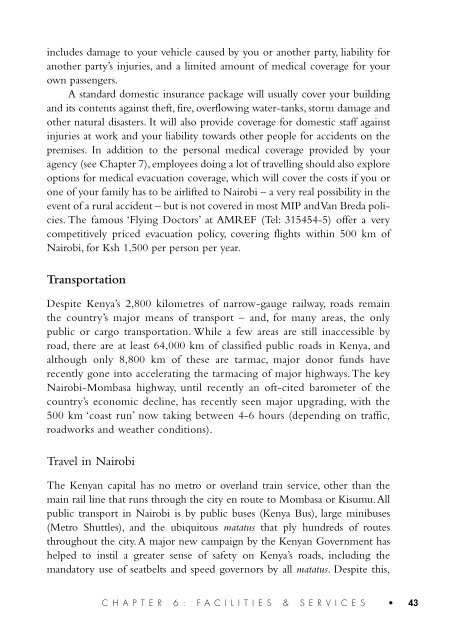KARIBU KENYA - UNON - the United Nations Office at Nairobi
KARIBU KENYA - UNON - the United Nations Office at Nairobi
KARIBU KENYA - UNON - the United Nations Office at Nairobi
You also want an ePaper? Increase the reach of your titles
YUMPU automatically turns print PDFs into web optimized ePapers that Google loves.
includes damage to your vehicle caused by you or ano<strong>the</strong>r party, liability for<br />
ano<strong>the</strong>r party’s injuries, and a limited amount of medical coverage for your<br />
own passengers.<br />
A standard domestic insurance package will usually cover your building<br />
and its contents against <strong>the</strong>ft, fire, overflowing w<strong>at</strong>er-tanks, storm damage and<br />
o<strong>the</strong>r n<strong>at</strong>ural disasters. It will also provide coverage for domestic staff against<br />
injuries <strong>at</strong> work and your liability towards o<strong>the</strong>r people for accidents on <strong>the</strong><br />
premises. In addition to <strong>the</strong> personal medical coverage provided by your<br />
agency (see Chapter 7), employees doing a lot of travelling should also explore<br />
options for medical evacu<strong>at</strong>ion coverage, which will cover <strong>the</strong> costs if you or<br />
one of your family has to be airlifted to <strong>Nairobi</strong> – a very real possibility in <strong>the</strong><br />
event of a rural accident – but is not covered in most MIP and Van Breda policies.<br />
The famous ‘Flying Doctors’ <strong>at</strong> AMREF (Tel: 315454-5) offer a very<br />
competitively priced evacu<strong>at</strong>ion policy, covering flights within 500 km of<br />
<strong>Nairobi</strong>, for Ksh 1,500 per person per year.<br />
Transport<strong>at</strong>ion<br />
Despite Kenya’s 2,800 kilometres of narrow-gauge railway, roads remain<br />
<strong>the</strong> country’s major means of transport – and, for many areas, <strong>the</strong> only<br />
public or cargo transport<strong>at</strong>ion. While a few areas are still inaccessible by<br />
road, <strong>the</strong>re are <strong>at</strong> least 64,000 km of classified public roads in Kenya, and<br />
although only 8,800 km of <strong>the</strong>se are tarmac, major donor funds have<br />
recently gone into acceler<strong>at</strong>ing <strong>the</strong> tarmacing of major highways.The key<br />
<strong>Nairobi</strong>-Mombasa highway, until recently an oft-cited barometer of <strong>the</strong><br />
country’s economic decline, has recently seen major upgrading, with <strong>the</strong><br />
500 km ‘coast run’ now taking between 4-6 hours (depending on traffic,<br />
roadworks and wea<strong>the</strong>r conditions).<br />
Travel in <strong>Nairobi</strong><br />
The Kenyan capital has no metro or overland train service, o<strong>the</strong>r than <strong>the</strong><br />
main rail line th<strong>at</strong> runs through <strong>the</strong> city en route to Mombasa or Kisumu.All<br />
public transport in <strong>Nairobi</strong> is by public buses (Kenya Bus), large minibuses<br />
(Metro Shuttles), and <strong>the</strong> ubiquitous m<strong>at</strong><strong>at</strong>us th<strong>at</strong> ply hundreds of routes<br />
throughout <strong>the</strong> city. A major new campaign by <strong>the</strong> Kenyan Government has<br />
helped to instil a gre<strong>at</strong>er sense of safety on Kenya’s roads, including <strong>the</strong><br />
mand<strong>at</strong>ory use of se<strong>at</strong>belts and speed governors by all m<strong>at</strong><strong>at</strong>us. Despite this,<br />
CHAPTER 6: FACILITIES & SERVICES • 43


